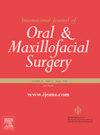Pediatric mandibular malignancies: a comprehensive analysis of SEER data
IF 2.2
3区 医学
Q2 DENTISTRY, ORAL SURGERY & MEDICINE
International journal of oral and maxillofacial surgery
Pub Date : 2025-02-01
DOI:10.1016/j.ijom.2024.08.002
引用次数: 0
Abstract
Mandibular malignancies are rare in the pediatric population and subsequently not well characterized. SEER 18 registry data was collected, applying age 0–18 years and ICD-O-3 code C41.1 (‘mandible’). Univariate Cox regression analysis was conducted, and hazard ratios (HR) were calculated for overall survival (OS) and disease-specific survival (DSS) according to patient demographics, tumor characteristics, and treatment. Kaplan–Meier survival curves were generated for OS and DSS. Sixty-four patients met the inclusion criteria. The median age at diagnosis was 13.0 years, and median survival was 8.7 years. Osteosarcoma was the most common histological diagnosis (n = 22). Sex, race, age (<13 vs ≥13 years), histological type, odontogenic origin, and treatment modality were found not to be associated with OS or DSS. The SEER stage ‘distant’ was significantly associated with an elevated HR of 6.28 for DSS (P = 0.027) and 5.29 for OS (P = 0.025). Kaplan–Meier survival curves demonstrated significantly lower 5-year DSS (P<0.001) and OS (P<0.001) for SEER ‘distant’ stage. This study includes the analysis of a large number of pediatric mandibular malignancies when compared to previous studies. ‘Distant’ stage was associated with decreased survival. Early clinical suspicion and diagnosis are paramount for improved survival.
小儿下颌骨恶性肿瘤:SEER 数据综合分析。
下颌骨恶性肿瘤在儿童群体中非常罕见,因此其特征并不明显。我们收集了 SEER 18 登记数据,适用年龄为 0-18 岁,ICD-O-3 编码为 C41.1("下颌骨")。进行了单变量考克斯回归分析,并根据患者人口统计学特征、肿瘤特征和治疗方法计算了总生存率(OS)和疾病特异性生存率(DSS)的危险比(HR)。并生成了 OS 和 DSS 的 Kaplan-Meier 生存曲线。64名患者符合纳入标准。确诊时的中位年龄为13.0岁,中位生存期为8.7年。骨肉瘤是最常见的组织学诊断(22 例)。性别、种族、年龄
本文章由计算机程序翻译,如有差异,请以英文原文为准。
求助全文
约1分钟内获得全文
求助全文
来源期刊
CiteScore
5.10
自引率
4.20%
发文量
318
审稿时长
78 days
期刊介绍:
The International Journal of Oral & Maxillofacial Surgery is one of the leading journals in oral and maxillofacial surgery in the world. The Journal publishes papers of the highest scientific merit and widest possible scope on work in oral and maxillofacial surgery and supporting specialties.
The Journal is divided into sections, ensuring every aspect of oral and maxillofacial surgery is covered fully through a range of invited review articles, leading clinical and research articles, technical notes, abstracts, case reports and others. The sections include:
• Congenital and craniofacial deformities
• Orthognathic Surgery/Aesthetic facial surgery
• Trauma
• TMJ disorders
• Head and neck oncology
• Reconstructive surgery
• Implantology/Dentoalveolar surgery
• Clinical Pathology
• Oral Medicine
• Research and emerging technologies.

 求助内容:
求助内容: 应助结果提醒方式:
应助结果提醒方式:


